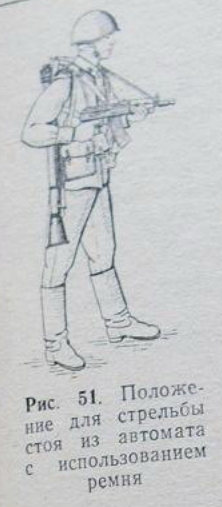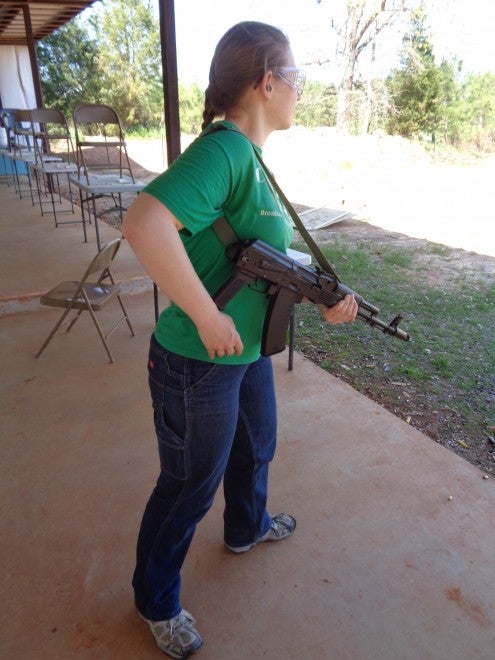I doubt that any of my readers have never seen a film in which a suitably menacing-looking Kalashnikov rifle was used this way: With the sling over the shoulder, stock folded, pointing from the hip:
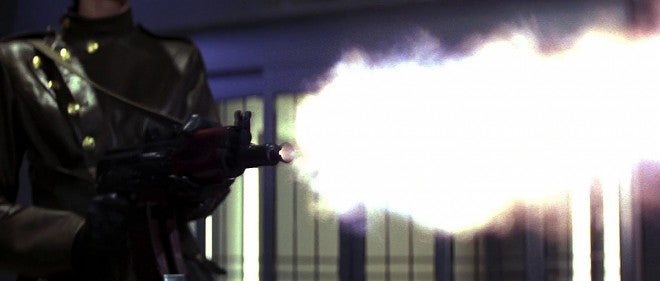
A common portrayal of the folding-stock AK rifle: menacingly held at the hip, supported by the sling, blazing away on fully automatic. To those who use firearms regularly, a somewhat dubious method of using the gun, but how bad is it, really? Image source: IMFDB.org
When one comes into ownership of a folding-stocked rifle of this type, the reason for this portrayal becomes obvious: It feels right. When the rifle is slung over the shoulder with the stock folded, muzzle pointing down, the rifle comes to the hands easily in this manner.
Because it felt so natural to me, I obtained a digital copy of the AKS-74U manual to see if it said anything about this. Sure enough, it did:
The accompanying text describes this method of point shooting thusly (thanks to Ensign Expendable of the Soviet Gun Archives blog for the manual and its translation):
Page 70:
51. When moving out to exercises and on march, the rifle is carried on its sling in the “by the sling”, “behind the back”, and “on the chest” positions (fig. 42). The sling must be adjusted so that the rifle does not knock on hard parts of the kit. The rifle is carried with a magazine inserted and the stock folded. The rest of the magazines are in the pouch. During breaks between exercises and at rest stops, the rifle is held by the rifleman “by the sling” or in his hands, and by a grenadier “on the chest” (fig. 43).
Pages 100-101:
99. To take aim while standing, you must:
- If the rifle is in the “by the sling” position: half-turn to the right relative to your target, and move your left foot about shoulder width apart, as convenient for the rifleman, spreading your weight between both legs. At the same time, moving your right hand up the sling, take the rifle off your shoulder, grasp it with your left hand by the hand guard, open the stock with your right hand, grip the pistol grip, and energetically raise the muzzle towards the target.
- If the rifle is in the “on the chest” position: take the hand guard with your left hand, and move it slightly up and forward. Take your right hand from underneath the sling, and throw the sling over your head. At the same time, make a half-turn to the right… (same as in part 1). (fig. 50). When a grenadier takes aim while standing, his rifle is, as a rule, “by the sling” (fig. 51). When the grenadier takes aim with his grenade launcher while standing, the rifle is moved to the “behind the back” position (fig. 52), for which the grenadier takes his grenade launcher with his left hand, takes the carbine and ring of the sling with his right hand, and moves the rifle to his back, after which he prepares for firing the grenade launcher.
100. When taking aim with your rifle “on the chest”, it is allowed to keep the sling around your neck and use it to brace your rifle (fig. 53).
Well… It’s in the manual! Let’s try it out!
First, my SO and I practiced presenting the weapon to the target from the slung position; her being much more photogenic than I, of course:
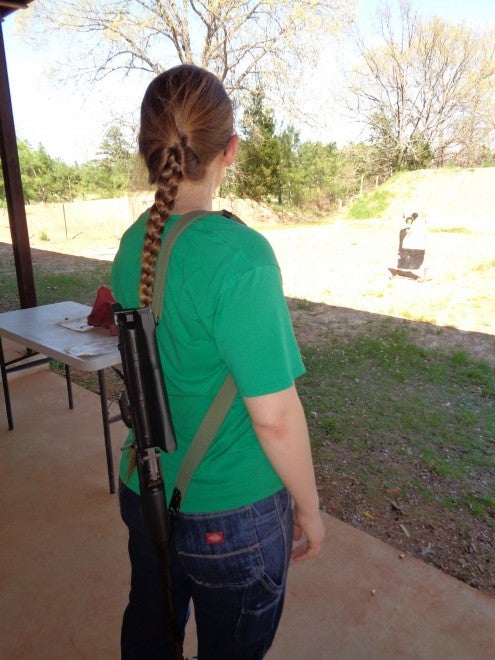
Sitting around, waiting for something to happen. In this shot, the rifle is not hiked up quite as high as the manual portrays.
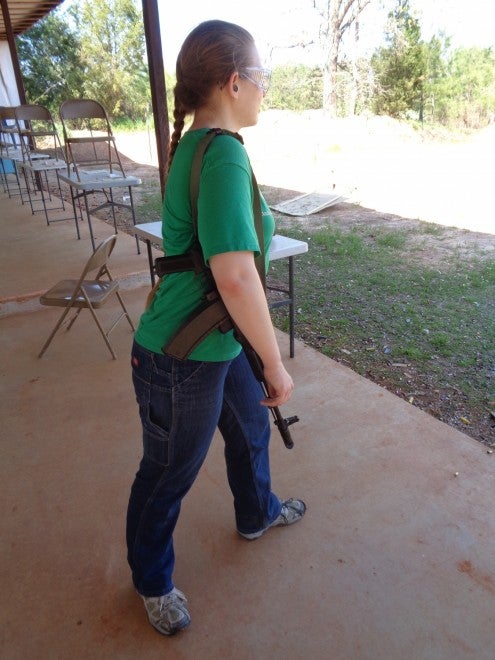
The first step is to take one step back with the right foot. The rifle’s inertia and weight carries it forward even further than is shown in this shot, and it is ready to be grabbed, if the user times it right. To complete the move, the user’s hands would already be moving.
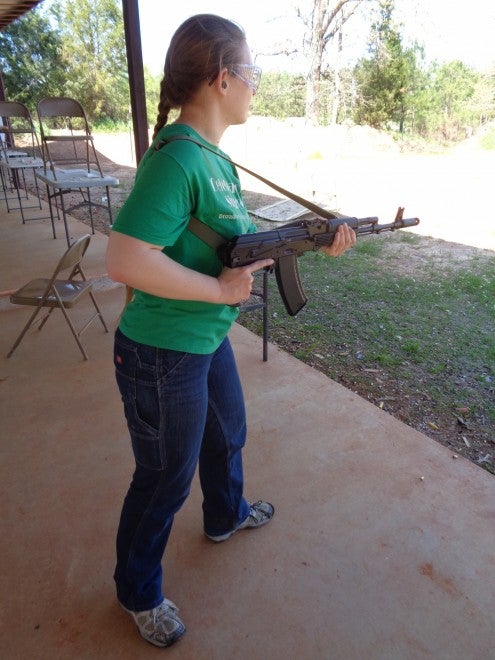
Then move your right hand over the safety, pushing it to the “semi” position (not depicted here) and acquire the pistol grip with your shooting hand.
I tried shooting using this method twice at the seven yard line, and once at the five yard line, to get an idea of its effectiveness. I was not shooting for speed, though I was trying to keep up a reasonable rate of fire. Due to mounting limitations, the chests of the silhouette targets were about right for a kneeling man, not a standing one. Accuracy was… Not good:
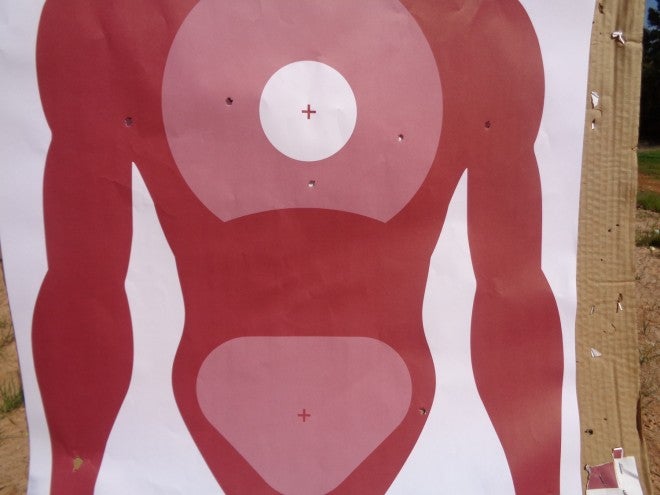
The first seven-yard line group. Six shots hit the paper, our of ten fired. When using this method, one had to struggle to keep rounds high enough to be effective. Against a standing opponent, this would have been about hip-level.
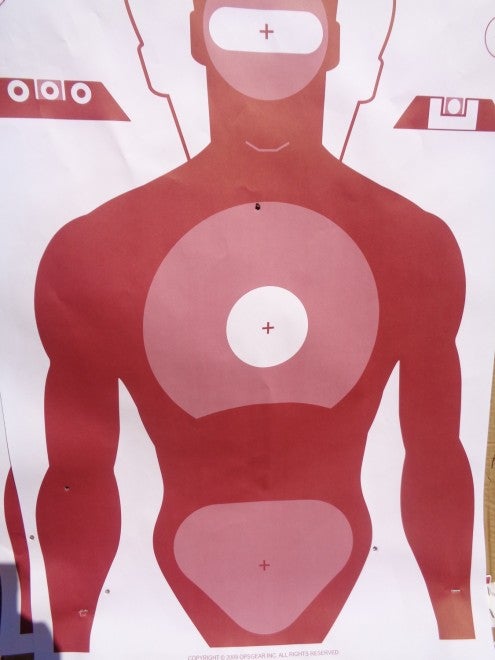
The second seven-yard group was even worse. The struggle to keep rounds high enough to be on target is evident here.

The five-yard target. Considerably better accuracy, only the first shot missed the target. The rounds, though, are still very low, the majority being about shin-level for a standing man.
Frankly, shooting the weapon this way is highly unpleasant, as the characteristic muzzle brake blows gas into the shooter’s face. I can only imagine the discomfort when shooting an AKS-74U with its 8″ barrel.
This technique, though it is in the manual for the AKS-74U, is not one I could recommend for distances above a few yards. I ceased shooting from this position due to safety concerns; while I think it’s possible that a soldier could practice enough to get reasonable accuracy at these distances, where would he practice? It’s reasonable to assume that better hit probability and speed could be achieved if the weapon were set to full auto instead of semi, but that doesn’t really mate well with the technique, as the shooter would have to ensure that he didn’t push the safety beyond the “full” position and into “semi”, and that takes time.
I certainly think this point shooting technique is better than dying because you couldn’t get your weapon into action quickly enough. I don’t think it’s better than anything else, though, and I think it provides a strong argument for single-point slings.
There is one last consideration: The manual specifically prescribes this method for the grenadier – i.e. RPG carrier – and the rifle isn’t his primary weapon. That doesn’t make the method any more effective, of course, but if the grenadier is using his RPG-7, and has to switch to the rifle, this is the natural way that one would do that. Hopefully for any grenadiers thus taught, their targets were not so far away!
 Your Privacy Choices
Your Privacy Choices
